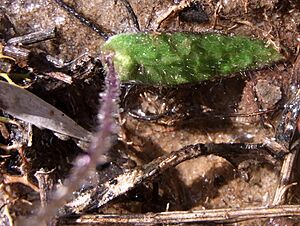Caladenia minorata facts for kids
Quick facts for kids Small waxlip orchid |
|
|---|---|
 |
|
| Caladenia minorata growing in Ku-ring-gai Chase National Park |
|
| Scientific classification | |
| Genus: |
Caladenia
|
| Species: |
minorata
|
| Synonyms | |
|
Glossodia minor R.Br. |
|
The small waxlip orchid, also known as Caladenia minorata, is a beautiful plant. It belongs to the orchid family and grows only in eastern Australia. This special orchid grows from the ground and has a single, very hairy leaf. Its flowers are a stunning deep violet-blue color.
For a long time, this orchid was called Glossodia minor. It was first described in 1810 by a famous Scottish botanist named Robert Brown. However, new scientific studies show that it actually fits better into the Caladenia group. It looks a lot like another orchid, Caladenia major, but the small waxlip orchid is smaller in every way.
Contents
What Does the Small Waxlip Orchid Look Like?
The small waxlip orchid is a plant that grows from an underground tuber. This means it has a special part underground that stores food. It's a perennial plant, so it lives for more than two years. It's also deciduous, meaning some parts might die back in certain seasons.
Leaves and Flowers
- Leaf: It has one dark green leaf that is very hairy. The leaf is shaped like an egg and lies flat on the ground. It's about 1 to 3 centimeters (0.4 to 1.2 inches) long and 0.8 to 1 centimeter (0.3 to 0.4 inches) wide.
- Flowers: The plant usually has one or two flowers. These flowers are a deep violet-blue color, but sometimes they can be white. Each flower is about 2 to 2.5 centimeters (0.8 to 1 inch) long and wide. They grow on a stem that can be 4 to 16 centimeters (1.6 to 6.3 inches) tall.
Flower Parts
The outside of the flower's sepals and petals is light-colored and hairy.
- Dorsal Sepal: This is the top sepal. It's about 1.2 to 1.5 centimeters (0.5 to 0.6 inches) long and 0.3 to 0.5 centimeters (0.1 to 0.2 inches) wide.
- Lateral Sepals: These are the two side sepals. They are similar in size to the top sepal and spread out.
- Petals: The petals are about 1 to 1.3 centimeters (0.4 to 0.5 inches) long and 0.3 to 0.5 centimeters (0.1 to 0.2 inches) wide. They also spread out widely.
- Labellum: This is a special lip-shaped petal. It's shaped like a long heart, about 0.4 to 0.5 centimeters (0.16 to 0.2 inches) long and 0.2 to 0.3 centimeters (0.08 to 0.12 inches) wide. It's bluish-purple with a white tip.
At the base of the labellum, there are two large, club-shaped parts called calli. They are joined at their bases and have a fleshy black top.
When Does it Flower?
The small waxlip orchid usually flowers from July to October. It often flowers much more after a bushfire.
Where Does the Small Waxlip Orchid Grow?
You can mostly find the small waxlip orchid along the eastern coast of Queensland, New South Wales, and Victoria.
New South Wales Habitat
In New South Wales, it is most common in coastal heathland areas. However, it has also been found as far inland as Temora.
Victoria Habitat
In Victoria, it mainly grows in coastal areas with grasstrees in East Gippsland. There are also records of it growing as far west as Wilsons Promontory.


